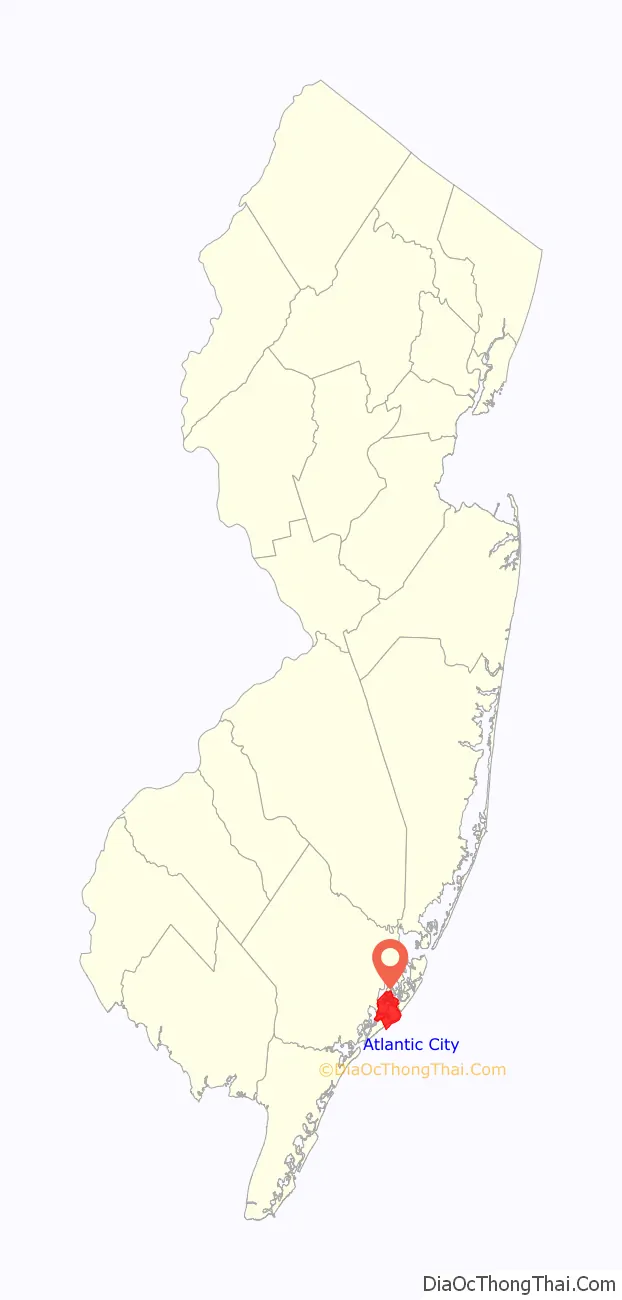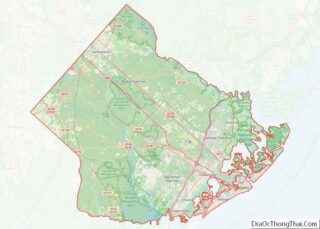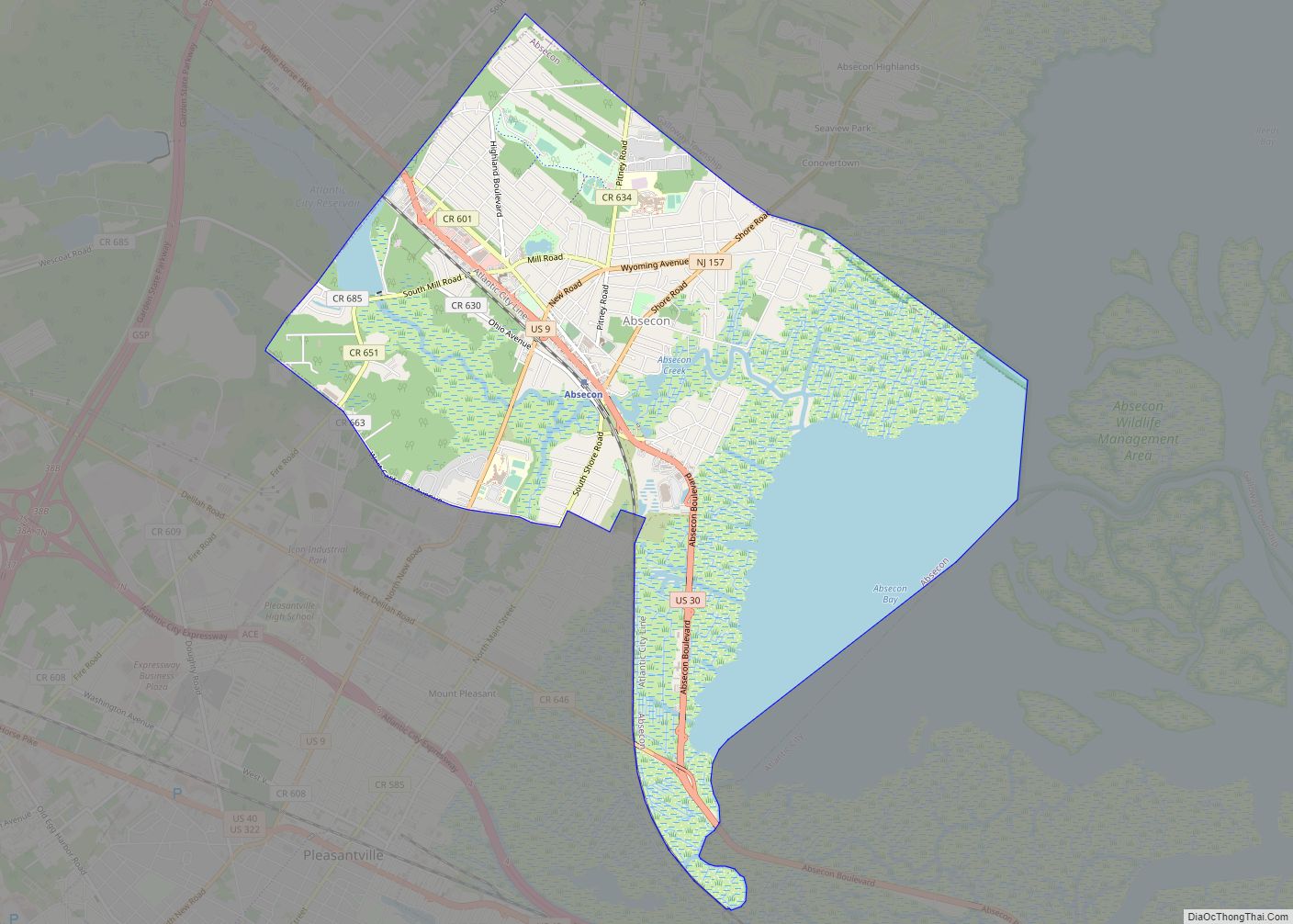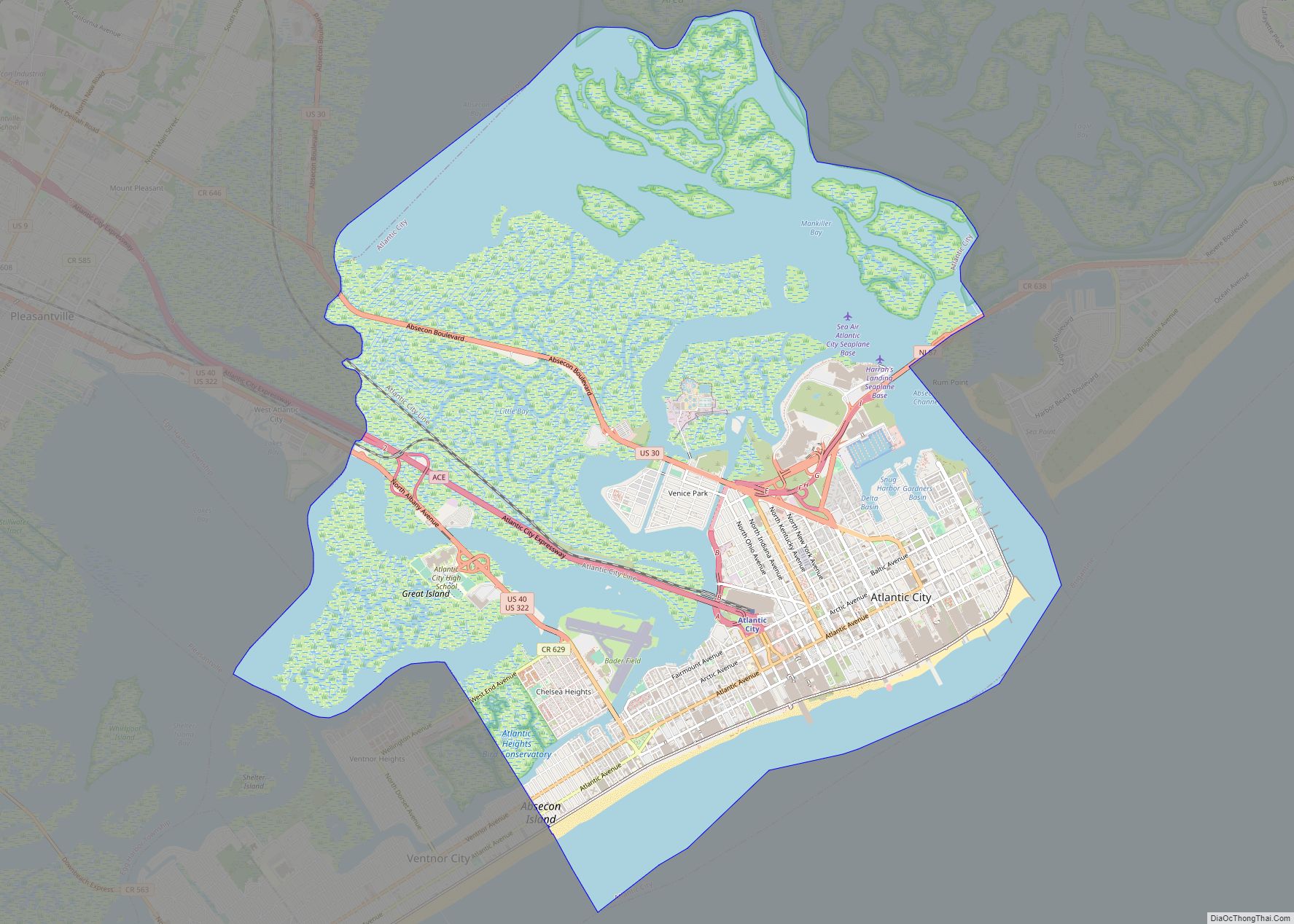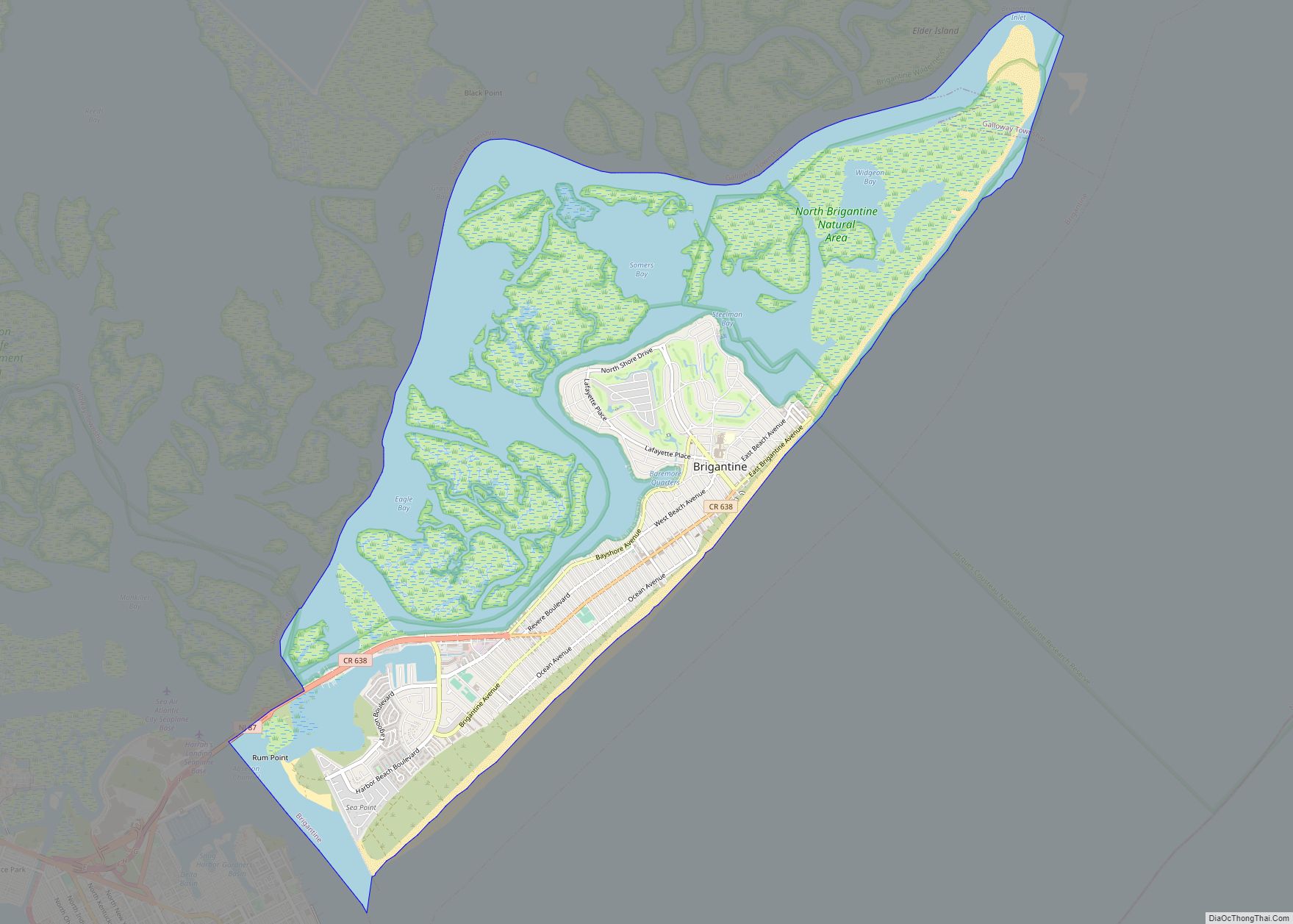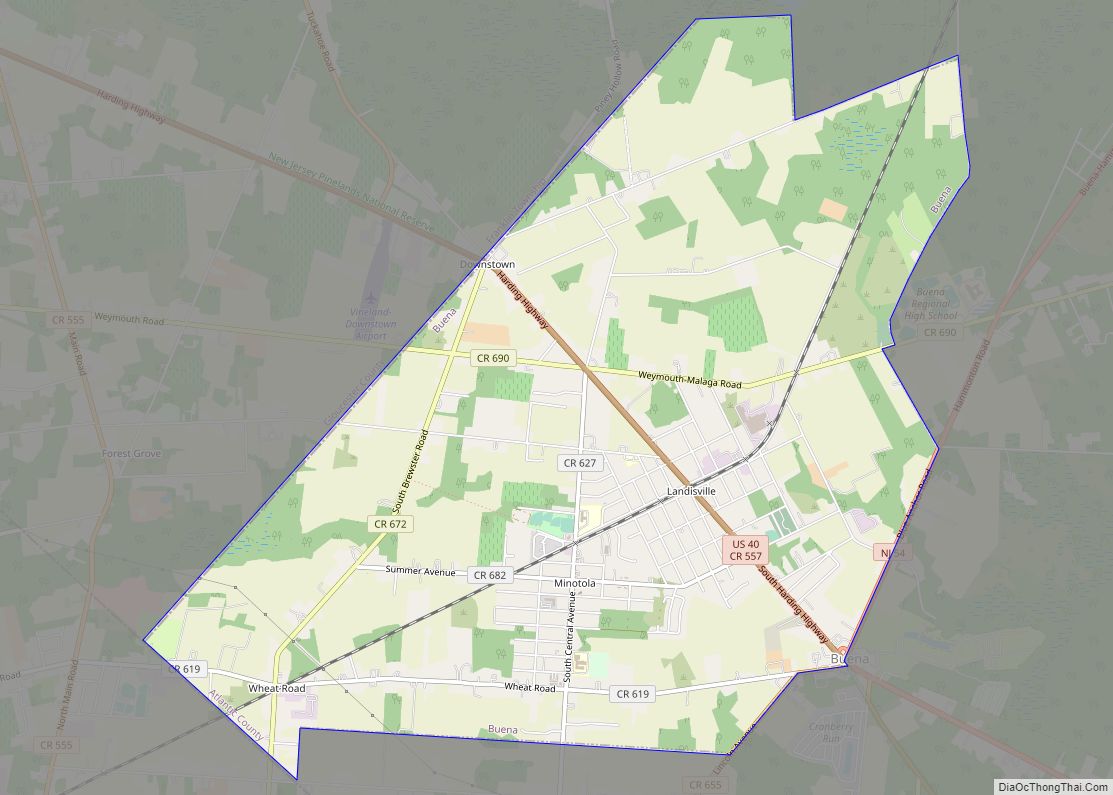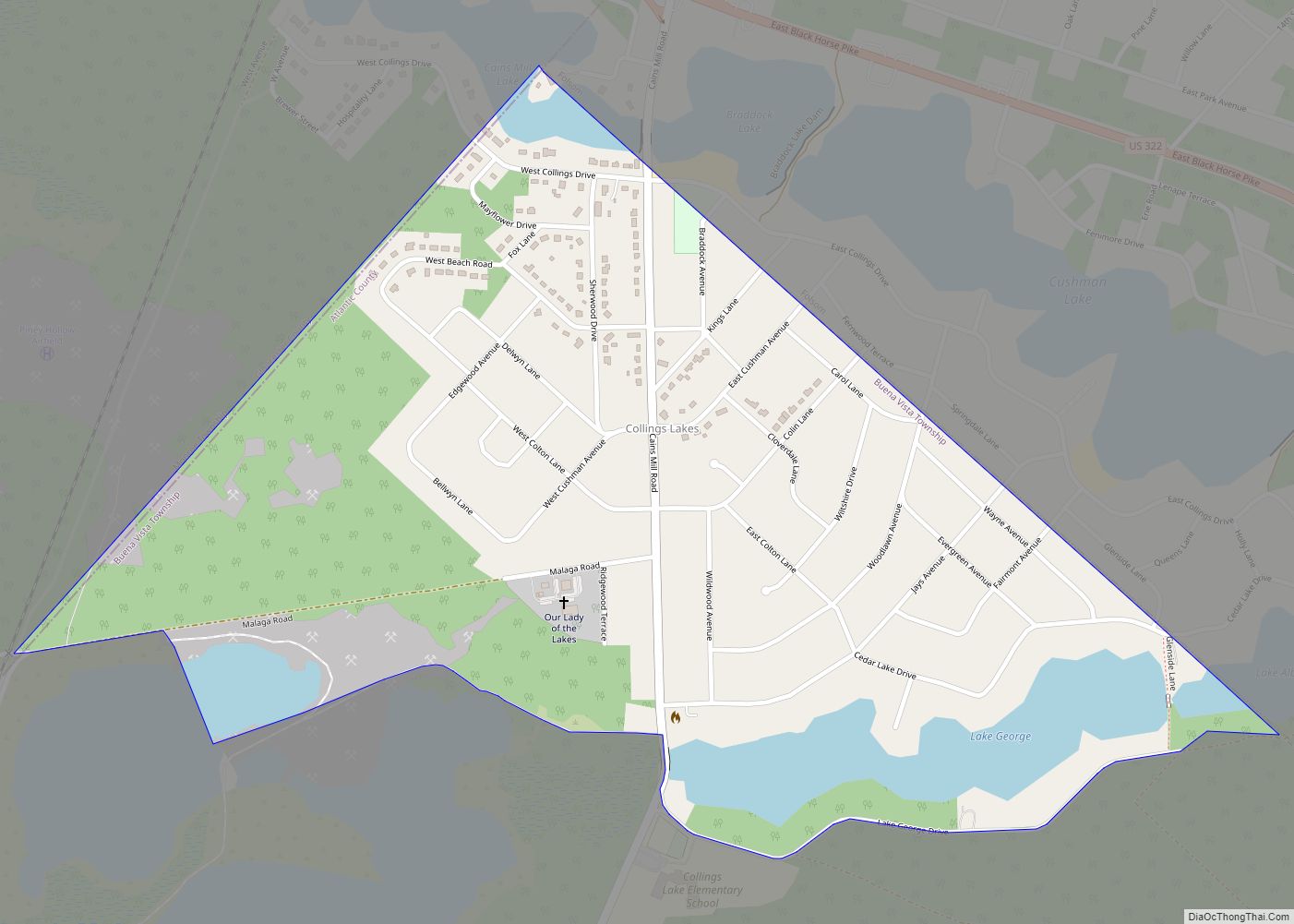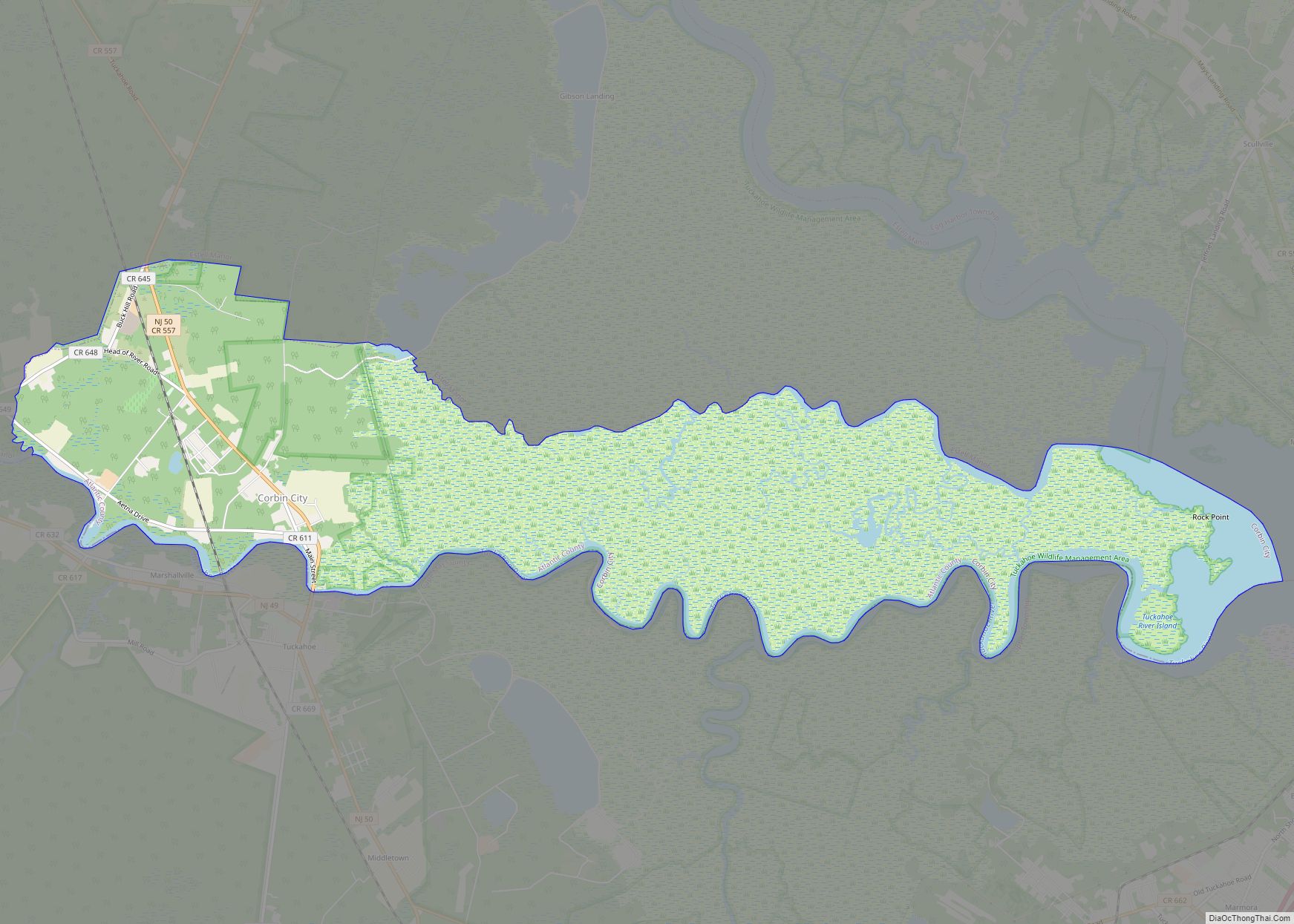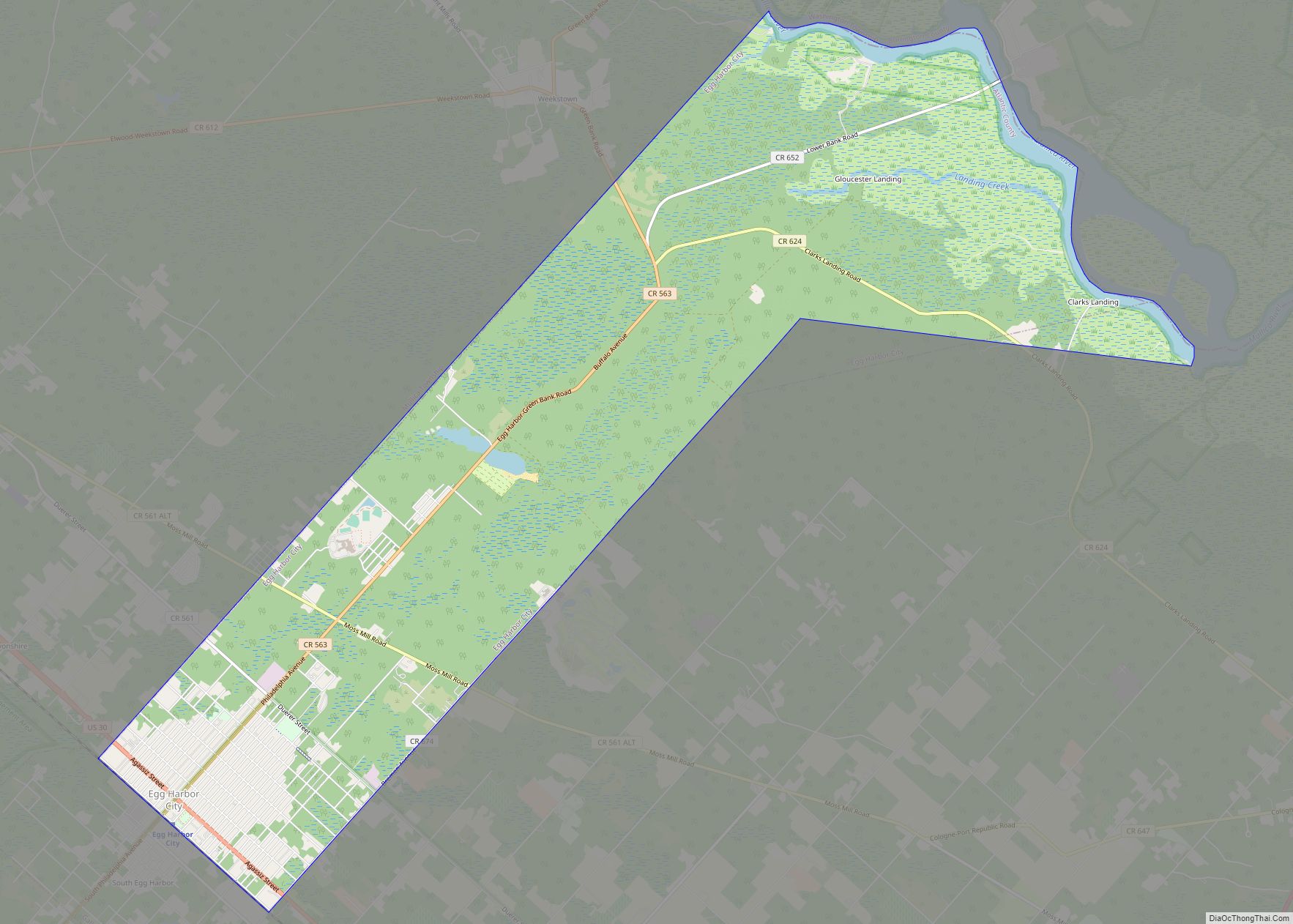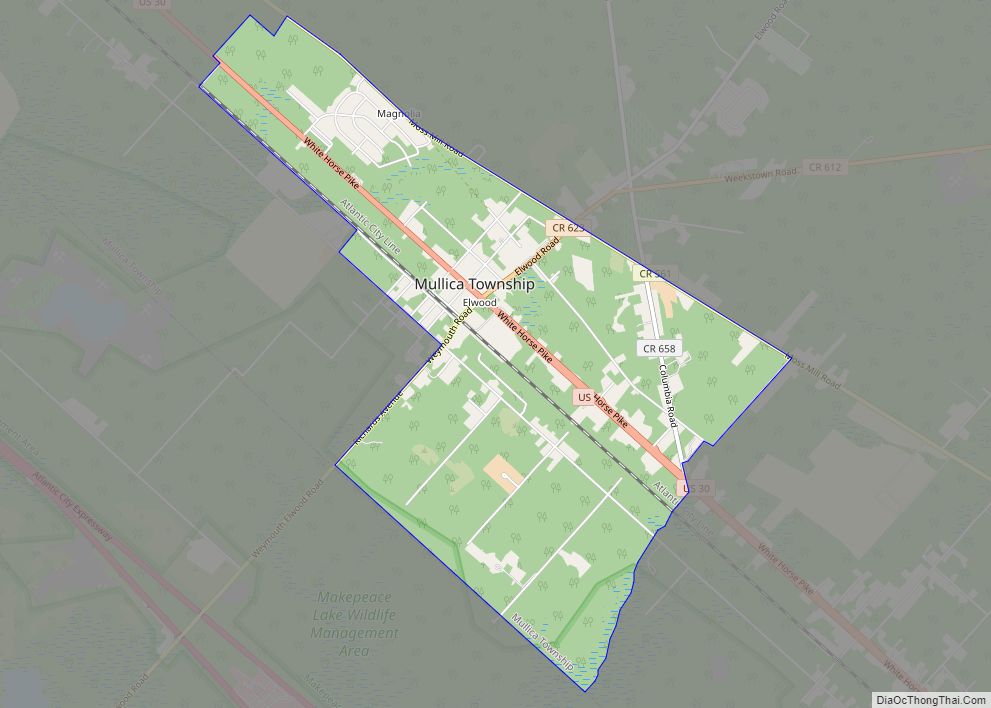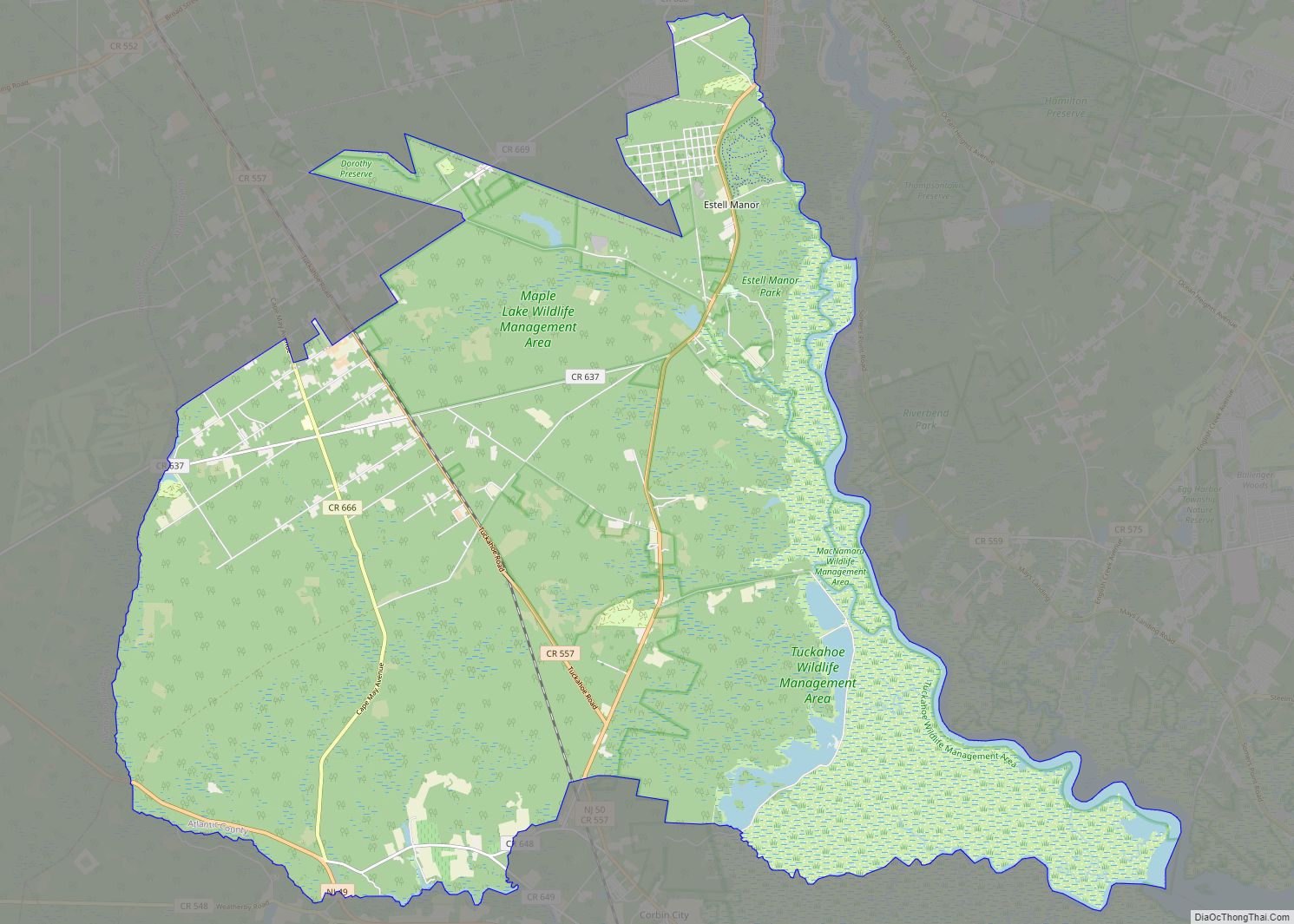| Name: | Atlantic City city |
|---|---|
| LSAD Code: | 25 |
| LSAD Description: | city (suffix) |
| State: | New Jersey |
| County: | Atlantic County |
| Incorporated: | May 1, 1854 |
| Elevation: | 7 ft (2 m) |
| Land Area: | 10.76 sq mi (27.87 km²) |
| Water Area: | 6.45 sq mi (16.72 km²) 37.50% |
| Population Density: | 3,577.8/sq mi (1,381.4/km²) |
| Area code: | 609 |
| FIPS code: | 3402080 |
| GNISfeature ID: | 0885142 |
| Website: | www.cityofatlanticcity.org |
Online Interactive Map
Click on ![]() to view map in "full screen" mode.
to view map in "full screen" mode.
Atlantic City location map. Where is Atlantic City city?
History
Settlement
For many years before the city’s founding, the island site of the future settlement was the summer home of the Lenape Native Americans. While the precise date of the first permanent occupation of what came to be Atlantic City by European settlers has not been precisely determined, it is commonly thought that in 1783 Jeremiah Leeds first built and occupied an all year home on the island. However, it was not until 1850 that the idea arose to develop the location into a resort town and in early 1853 the name “Atlantic City” was adopted.
Because of its location in South Jersey, which hugs the Atlantic Ocean between marshlands and islands, Atlantic City was viewed by developers as prime real estate and a potential resort town. In 1853, the first commercial hotel, the Belloe House, which was built at the intersection of Massachusetts and Atlantic Avenues.
The city was incorporated in 1854, the same year train service began on the Camden and Atlantic Railroad. Built on the edge of the bay, this served as the direct link of this remote parcel of land with Philadelphia, Pennsylvania. That same year, construction of the Absecon Lighthouse, designed by George Meade of the Corps of Topographical Engineers, was approved, with work initiated the next year. By 1874, almost 500,000 passengers a year were coming to Atlantic City by rail. In Boardwalk Empire: The Birth, High Times, and Corruption of Atlantic City, “Atlantic City’s Godfather” Nelson Johnson describes the inspiration of Jonathan Pitney (the “Father of Atlantic City”) to develop Atlantic City as a health resort, his efforts to convince the municipal authorities that a railroad to the beach would be beneficial, his successful alliance with Samuel Richards (entrepreneur and member of the most influential family in southern New Jersey at the time) to achieve that goal, the actual building of the railroad, and the experience of the first 600 riders, who “were chosen carefully by Samuel Richards and Jonathan Pitney”:
The first boardwalk was built in 1870 along a portion of the beach in an effort to help hotel owners keep sand out of their lobbies. Businesses were restricted and the boardwalk was removed each year at the end of the peak season. Because of its effectiveness and popularity, the boardwalk was expanded in length and width, and modified several times in subsequent years. The historic length of the boardwalk, before the destructive 1944 Great Atlantic Hurricane, was about 7 mi (11 km) and it extended from Atlantic City to Longport, through Ventnor and Margate.
The first road connecting the city to the mainland at Pleasantville was completed in 1870 and charged a 30-cent toll. Albany Avenue was the first road to the mainland available without a toll.
By 1878, because of the growing popularity of the city, one railroad line could no longer keep up with demand. Soon, the Philadelphia and Atlantic City Railway was also constructed to transport tourists to Atlantic City. At this point massive hotels like The United States and Surf House, as well as smaller rooming houses, had sprung up all over town. The United States Hotel took up a full city block between Atlantic, Pacific, Delaware, and Maryland Avenues. These hotels were not only impressive in size, but featured the most updated amenities, and were considered quite luxurious for their time.
Boom period
In the early part of the 20th century, Atlantic City went through a radical building boom. Many of the modest boarding houses that dotted the boardwalk were replaced with large hotels. Two of the city’s most distinctive hotels were the Marlborough-Blenheim Hotel and the Traymore Hotel.
In 1903, Josiah White III bought a parcel of land near Ohio Avenue and the boardwalk and built the Queen Anne style Marlborough House. The hotel was a success and, in 1905–1906, he chose to expand the hotel and bought another parcel of land adjacent to his Marlborough House. In an effort to make his new hotel a source of conversation, White hired the architectural firm of Price and McLanahan. The firm made use of reinforced concrete, a new building material invented by Jean-Louis Lambot in 1848 (Joseph Monier received the patent in 1867). The hotel’s Spanish and Moorish themes, capped off with its signature dome and chimneys, represented a step forward from other hotels that had a classically designed influence. White named the new hotel the Blenheim and merged the two hotels into the Marlborough-Blenheim. Bally’s Atlantic City was later constructed at this location.
The Traymore Hotel was located at the corner of Illinois Avenue and the boardwalk. Begun in 1879 as a small boarding house, the hotel grew through a series of uncoordinated expansions. By 1914, the hotel’s owner, Daniel White, taking a hint from the Marlborough-Blenheim, commissioned the firm of Price and McLanahan to build an even bigger hotel. Rising 16 stories, the tan brick and gold-capped hotel would become one of the city’s best-known landmarks. The hotel made use of ocean-facing hotel rooms by jutting its wings farther from the main portion of the hotel along Pacific Avenue.
One by one, additional large hotels were constructed along the boardwalk, including the Brighton, Chelsea, Shelburne, Ambassador, Ritz Carlton, Mayflower, Madison House, and the Breakers. The Quaker-owned Chalfonte House, opened in 1868, and Haddon House, opened in 1869, flanked North Carolina Avenue at the beach end. Over the years, their original wood-frame structures would be enlarged, and even moved closer to the beach. The modern Chalfonte Hotel, eight stories tall, opened in 1904. The modern Haddon Hall was built in stages and was completed in 1929, at eleven stories. By this time, they were under the same ownership and merged into the Chalfonte-Haddon Hall Hotel, becoming the city’s largest hotel with nearly 1,000 rooms. By 1930, the Claridge, the city’s last large hotel before the casinos, opened its doors. The 400-room Claridge was built by a partnership that included renowned Philadelphia contractor John McShain. At 24 stories, it would become known as the “Skyscraper by the Sea”. The city became known as “The World’s Playground”.
In 1883, salt water taffy was conceived in Atlantic City by David Bradley. The traditional story is that Bradley’s shop was flooded after a major storm, soaking his taffy with salty Atlantic Ocean water. He sold some “salt water taffy” to a girl, who proudly walked down to the beach to show her friends. Bradley’s mother was in the back of the store when the sale was made, and loved the name, and so salt water taffy was born.
Prohibition era
The 1920s, with tourism at its peak, are considered by many historians as Atlantic City’s golden age. During Prohibition, which was enacted nationally in 1919 and lasted until 1933, much liquor was consumed and gambling regularly took place in the back rooms of nightclubs and restaurants. It was during Prohibition that racketeer and political boss Enoch L. “Nucky” Johnson rose to power. Prohibition was largely unenforced in Atlantic City, and, because alcohol that had been smuggled into the city with the acquiescence of local officials could be readily obtained at restaurants and other establishments, the resort’s popularity grew further. The city then dubbed itself as “The World’s Playground”. Nucky Johnson’s income, which reached as much as $500,000 annually, came from the kickbacks he took on illegal liquor, gambling and prostitution operating in the city, as well as from kickbacks on construction projects.
During this time, Atlantic City was led by mayor Edward L. Bader, known for his contributions to the construction, athletics and aviation of Atlantic City. Despite opposition, he had Atlantic City purchase the land that became the city’s municipal airport and high school football stadium, both of which were later named Bader Field in his honor. He led the initiative, in 1923, to construct the Atlantic City High School at Albany and Atlantic Avenues. Bader, in November 1923, initiated a public referendum, during the general election, at which time residents approved the construction of a Convention Center. The city passed an ordinance approving a bond issue for $1.5 million to be used for the purchase of land for Convention Hall, now known as the Boardwalk Hall, finalized on September 30, 1924. Bader was also a driving force behind the creation of the Miss America competition.
In May 1929, Johnson hosted a conference for organized crime figures from all across America that created a National Crime Syndicate. The men who called this meeting were Masseria family lieutenant Charles “Lucky” Luciano and former Chicago South Side Gang boss Johnny “the Fox” Torrio, with heads of the Bugs and Meyer Mob, Meyer Lansky and Benjamin Siegel, being used as muscle for the meeting. Gangster and businessman Al Capone attended the conference and was photographed walking along the Atlantic City boardwalk with Johnson.
Nightclub era
The 1930s through the 1960s were a heyday for nightclub entertainment. Popular venues on the white-populated south side included the 500 Club, the Clicquot Club, and the Jockey Club. On the north side, home to African Americans in the racially segregated city, a black entertainment district reigned on Kentucky Avenue. Four major nightclubs—Club Harlem, the Paradise Club, Grace’s Little Belmont, and Wonder Gardens—drew both black and white patrons. During the summer tourist season, jazz and R&B music could be heard into the wee hours of the morning. Soul food restaurants and ribs joints also lined Kentucky Avenue, including Wash’s Restaurant, Jerry’s and Sap’s.
Decline and resurgence
Like many older East Coast cities after World War II, Atlantic City became plagued with poverty, crime, corruption, and general economic decline in the mid-to-late 20th century. The neighborhood known as the “Inlet” became particularly impoverished. The reasons for the resort’s decline were multi-layered. First, the automobile became more readily available to many Americans after the war. Atlantic City had initially relied upon visitors coming by train and staying for a couple of weeks. The car allowed them to come and go as they pleased, and many people would spend only a few days, rather than weeks. The advent of suburbia also played a significant role. With many families moving to their own private houses, luxuries such as home air conditioning and swimming pools diminished their interest in flocking to the luxury beach resorts during the hot summer. Finally, the rise of relatively cheap jet airline service allowed visitors to travel to year-round resort places such as Miami Beach and the Bahamas.
The city hosted the 1964 Democratic National Convention which nominated Lyndon Johnson for president and Hubert Humphrey as vice president. The convention and the press coverage it generated, however, cast a harsh light on Atlantic City, which by then was in the midst of a long period of economic decline. Many felt that the friendship between Johnson and Governor of New Jersey Richard J. Hughes led Atlantic City to host the Democratic Convention.
By the late 1960s, many of the resort’s once great hotels were suffering from high vacancy rates. Most of them were either shut down, converted to cheap apartments, or converted to nursing home facilities by the end of the decade. Prior to and during the advent of legalized gambling, many of these hotels were demolished. The Breakers, The Chelsea, the Brighton, the Shelburne, the Mayflower, the Traymore and the Marlborough-Blenheim were demolished in the 1970s and 1980s. Of the many pre-casino resorts that bordered the boardwalk, only the Claridge, the Dennis, the Ritz-Carlton, and the Haddon Hall survive to this day as parts of Bally’s Atlantic City, a condo complex, and Resorts Atlantic City. The old Ambassador Hotel was purchased by Ramada in 1978 and was gutted to become the Tropicana Casino and Resort Atlantic City, only reusing the steelwork of the original building. Smaller hotels off the boardwalk, such as the Madison also survived.
Legalized gambling
In an effort at revitalizing the city, New Jersey voters in 1976 passed a referendum, approving casino gambling for Atlantic City; this came after a 1974 referendum on legalized gambling failed to pass. Immediately after the legislation passed, the owners of the Chalfonte-Haddon Hall Hotel began converting it into the Resorts International. It was the first legal casino in the eastern United States when it opened on May 26, 1978. Other casinos were soon constructed along the Boardwalk and, later, in the marina district for a total of nine today. The introduction of gambling did not, however, quickly eliminate many of the urban problems that plagued Atlantic City. Many people have suggested that it only served to exacerbate those problems, as attested to by the stark contrast between tourism intensive areas and the adjacent impoverished working-class neighborhoods. In addition, Atlantic City has been less popular than Las Vegas as a gambling city in the United States. Donald Trump helped bring big name boxing bouts to the city to attract customers to his casinos. The boxer Mike Tyson had most of his fights in Atlantic City in the 1980s, which helped Atlantic City achieve nationwide attention as a gambling resort. Numerous highrise condominiums were built for use as permanent residences or second homes. By end of the decade it was one of the most popular tourist destinations in the United States.
On June 27, 2017, the United States Supreme Court agreed to hear Christie v. National Collegiate Athletic Association and heard oral arguments in December 2017. Then, on May 14, 2018, the Supreme Court ruled that the Professional and Amateur Sports Protection Act (PASPA) was unconstitutional. The act was overturned, allowing New Jersey to move ahead with plans to implement legalized sports betting.
Despite being the state to initiate the landmark ruling, New Jersey was actually the third state to legalize sports betting following Nevada and Delaware. Gov. Phil Murphy signed the legislation into law on June 11, 2018, prompting several casino brands to launch sportsbooks, particularly in Atlantic City.
Modern-day challenges
With the redevelopment of the Las Vegas Strip and the opening of Foxwoods Resort Casino and Mohegan Sun in Connecticut in the early 1990s, along with newly built casinos in the nearby Philadelphia metro area in the 2000s, Atlantic City’s tourism began to decline due to its failure to diversify away from gaming. Determined to expand, in 1999 the Atlantic City Redevelopment Authority partnered with Las Vegas casino mogul Steve Wynn to develop a new roadway to a barren section of the city near the Marina. Nicknamed “The Tunnel Project”, Steve Wynn planned the proposed ‘Mirage Atlantic City’ around the idea that he would connect the $330 million tunnel stretching 2.5 mi (4.0 km) from the Atlantic City Expressway to his new resort. The roadway was later officially named the Atlantic City-Brigantine Connector, and funnels incoming traffic off of the expressway into the city’s marina district and the city of Brigantine.
Although Wynn’s plans for development in the city were scrapped in 2002, the tunnel opened in 2001. The new roadway prompted Boyd Gaming in partnership with MGM/Mirage to build Atlantic City’s newest casino. Borgata opened in July 2003, and its success brought an influx of developers to Atlantic City with plans for building grand Las Vegas style mega casinos to revitalize the aging city.
Owing to economic conditions and the late 2000s recession, many of the proposed mega casinos never went further than the initial planning stages. One of these developers was Pinnacle Entertainment, who purchased the Sands Atlantic City for $250–$270 million, closed it on November 11, 2006, with plans to replace it with a larger casino. The following year, the resort was demolished in an implosion, the first of its kind in Atlantic City. While Pinnacle Entertainment intended to replace it with a $1.5–2 billion casino resort, the company canceled its construction plans and sold the land for $29.5 million. MGM Resorts International announced in October 2007 that it would pull out of all development for Atlantic City, effectively ending their plans for the MGM Grand Atlantic City.
In 2006, Morgan Stanley purchased 20 acres (8.1 ha) directly north of the Showboat Atlantic City Hotel and Casino for a new $2 billion plus casino resort. Revel Entertainment Group was named as the project’s developer for the Revel Casino. Revel was hindered with many problems, the biggest setback occurring in April 2010 when Morgan Stanley, the owner of 90% of Revel Entertainment Group, decided to discontinue funding for continued construction and put its stake in Revel up for sale. Early in 2010 the New Jersey state legislature passed a bill offering tax incentives to attract new investors and complete the job, but a poll by Fairleigh Dickinson University’s PublicMind released in March 2010 showed that 60% of voters opposed the legislation, and two of three of those who opposed it “strongly” opposed it. Ultimately, Governor Chris Christie offered Revel $261 million in state tax credits to assist the casino once it opened. As of March 2011, Revel had completed all of the exterior work and had continued work on the interior after finally receiving the funding necessary to complete construction. It had a soft opening in April 2012, and was fully open by May 2012. Ten months later, in February 2013, after serious losses and a write-down in the value of the resort from $2.4 billion to $450 million, Revel filed for Chapter 11 bankruptcy. It was restructured but still could not carry on and re-entered bankruptcy on June 19, 2014. It was put up for sale, however as no suitable bids were received the resort closed its doors on September 2, 2014. The property was bought by AC Ocean Walk, LLC for $200 million in 2017, and reopened in 2018 as Ocean Casino Resort.
In the wake of the closures and declining revenue from casinos, Governor Christie said in September 2014 that the state would consider a 2015 referendum to end the 40-year-old monopoly that Atlantic City holds on casino gambling and allowing gambling in other municipalities. With casino revenue declining from $5.2 billion in 2006 to $2.9 billion in 2013, the state saw a drop in money from its 8% tax on those earnings, which is used to fund programs for senior citizens and the disabled.
“Superstorm Sandy” struck Atlantic City on October 29, 2012, causing flooding and power-outages but left minimal damage to any of the tourist areas. The storm produced an all-time record low barometric pressure reading of 943 mb (27.85″) for not only Atlantic City, but the state of New Jersey.
The Atlantic City area had the highest rates of foreclosures in the nation in 2019. This has disproportionately affected Black residents in neighborhoods segregated by redlining, a legacy that is mirrored by the values of properties on the Monopoly game board.
After several casino closures and a worldwide pandemic, strikes and pickets were being threatened in June 2022 by casino employees which were short-staffed and wanted pay raises.
Atlantic City Road Map
Atlantic City city Satellite Map
Geography
According to the United States Census Bureau, Atlantic City had a total area of 17.21 square miles (44.59 km), including 10.76 square miles (27.87 km) of land and 6.45 square miles (16.72 km) of water (37.50%).
The city is located on 8.1 mi-long (13.0 km) Absecon Island, along with Ventnor City, Margate City and Longport to the southwest.
Atlantic City borders the Atlantic County municipalities of Absecon, Brigantine, Egg Harbor Township, Galloway Township, Pleasantville, and Ventnor City.
The city is located 60 mi (97 km) southeast of Philadelphia and 125 mi (201 km) south of New York City.
Unincorporated communities, localities and place names located partially or completely within the city include Chelsea, City Island, Great Island and Venice Park.
Climate
According to the Köppen climate classification system, Atlantic City has a humid subtropical climate (Cfa) with warm, moderately humid summers, cool winters and year-around precipitation. Cfa climates are characterized by all months having an average mean temperature above 32.0 °F (0.0 °C), at least four months with an average mean temperature at or above 50.0 °F (10.0 °C), at least one month with an average mean temperature at or above 72.0 °F (22.2 °C) and no significant precipitation difference between seasons. During the summer months in Atlantic City, a cooling afternoon sea breeze is present on most days, but episodes of extreme heat and humidity can occur with heat index values at or above 95.0 °F (35.0 °C). During the winter months, episodes of extreme cold and wind can occur with wind chill values below 0.0 °F (−17.8 °C). The plant hardiness zone at Atlantic City Beach is 7b with an average annual extreme minimum air temperature of 11.0 °F (−11.7 °C). The average seasonal (November–April) snowfall total is 12 to 18 in (300 to 460 mm), and the average snowiest month is February which corresponds with the annual peak in nor’easter activity.
Ecology
According to the A. W. Kuchler U.S. potential natural vegetation types, Atlantic City would have a dominant vegetation type of Northern Cordgrass (73) with a dominant vegetation form of Coastal Prairie (20).
See also
Map of New Jersey State and its subdivision: Map of other states:- Alabama
- Alaska
- Arizona
- Arkansas
- California
- Colorado
- Connecticut
- Delaware
- District of Columbia
- Florida
- Georgia
- Hawaii
- Idaho
- Illinois
- Indiana
- Iowa
- Kansas
- Kentucky
- Louisiana
- Maine
- Maryland
- Massachusetts
- Michigan
- Minnesota
- Mississippi
- Missouri
- Montana
- Nebraska
- Nevada
- New Hampshire
- New Jersey
- New Mexico
- New York
- North Carolina
- North Dakota
- Ohio
- Oklahoma
- Oregon
- Pennsylvania
- Rhode Island
- South Carolina
- South Dakota
- Tennessee
- Texas
- Utah
- Vermont
- Virginia
- Washington
- West Virginia
- Wisconsin
- Wyoming

